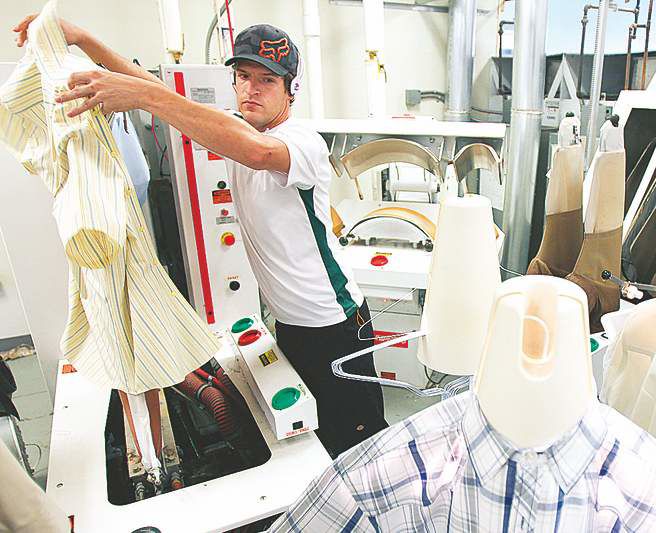Cleaners try to go greener
Published 5:00 am Monday, October 15, 2012

- Cathy's Cleaners employee Nicholas Davidson operates a shirt press machine. Between 85-90 percent of the items brought to Cathy's are wet-cleaned with the new machinery.
Having a work shirt in by 9 a.m., cleaned and pressed by 5 p.m. isn’t the only goal for dry cleaners in Central Oregon these days.
They’re also striving to be green.
“There’s a lot of influence from the consumers to go green,” said Mackey Carlson, co-owner and CEO of the Bend-based dry-cleaning company, A Greener Cleaner.
Along with consumer demand, the federal and state government has cracked down on cleaners, prompting changes towards greener practices.
Historically, dry cleaners have used a solvent called perchloroethylene, or perc, to clean “dry-clean-only” items.
But in the early 1990s, the U.S. Environmental Protection Agency began efforts to reduce the use of perc. The chemical has health risks for workers and the environment if dumped on the ground or released into the air. Earlier this year, the agency ruled perc a likely carcinogen.
Other federal and state rules restrict how dry cleaners use the chemical. For example, Oregon law requires dry cleaners to handle perc in a closed-loop system, where the solvent is never handled. It’s delivered directly from the truck into machine.
The regulations have prompted cleaners to search for alternatives to perc, such as other solvents considered to be less toxic, and a process called wet cleaning, which fuses traditional laundry ingredients — water and detergent — with computer-programmed washing machines.
Cathy’s Cleaners recently spent $60,000 to install wet-cleaning machinery at its Northeast Second Street location. While the company still dry-cleans with perc, Eyal Goldman, co-owner of Cathy’s, said 85-90 percent of the items now go through the wet-cleaning process.
“Now a ‘dry-clean only’ label to us is meaningless,” Goldman said. “If it says ‘dry-clean only,’ it doesn’t mean it is going in our dry-cleaning machine. In most cases, it doesn’t.”
In the wet-cleaning process, water, instead of a dry-cleaning solvent, is used with detergent, Goldman said.
In the past, “dry-clean only” items could not be washed in water because they would shrink, he said.
The technology in the new wet-cleaning machines, he said, provides about 30 programs, allowing operators to select different load sizes, water temperature, detergent combinations, tumble speeds and direction.
“It’s as green as you doing laundry at home,” Goldman said. “Even the greenest of dry cleaning can’t compare. It’s still a chemical, not water.”
The company uses perc for items that can’t be wet-cleaned, garments made with dyes that will bleed in water, those with decorations glued on with a water-soluble adhesive and delicate wools, he said.
Despite the reputation of perc, Goldman said when used properly it does not harm the environment.
In 1995, Oregon passed legislation requiring dry cleaning to become a zero-release industry, according to the DEQ. To eliminate the release of hazardous waste into the environment, it mandates waste management practices, such as closed-loop systems.
Dick DeZeeuw, program coordinator for DEQ, said nearly 150 dry cleaners in Oregon use perc, according to the DEQ’s 2011 data. If they follow state and federal regulations, he said, perc will usually stay out of the environment.
“California has a plan to phase perc out, but Oregon is taking a different approach,” DeZeeuw said. “Oregon is monitoring the dry cleaners and their operations.”
Still, some Oregon dry cleaners have moved away from the chemical, believing it’s an important part of being green.
John Madding, owner of Cascade Cleaners, said his company has been using wet-cleaning machines since 1997. About 70 percent of the items go through the wet-cleaning process, he said. For items that require dry cleaning, he said, he uses a hydrocarbon machine with a solvent called DF-2000, instead of perc.
In 2006, Mirror Pond Cleaners, located on Northwest Franklin Avenue, made the switch from perc to a silcone-based solvent after being cited by the DEQ for improperly storing, labeling and disposing of dry cleaning solvent.
Chad Allred, manager of operations at Mirror Pond Cleaners, said changing solvents had benefits beyond helping the environment.
“The clothes felt softer,” Allred said. “They were easier to press, and there was no smell. The lint was less, so it’s making the clothes last longer on the consumer end, (and) the colors are staying.”
Carlson, of A Greener Cleaner, said his company also uses liquid silicone as dry-cleaning solvent, as well as an all-natural detergent for his laundry.
“If (the solvent) is poured out onto the ground, it would turn to water, sand and carbon dioxide in less than 30 days,” he said.
Silicone solvent doesn’t have the same degreasing power as perc, he said, but that makes it gentler on clothes. To remove stains, he said, clothes are pre-spotted with a small amount of chemicals, which never go into the machines or down the drain. Instead, he said chemicals are vacuumed down into a separate container, put in a 50-gallon drum and hauled away by a waste disposal company.
“Ten years ago, not many people were talking about being green,” he said. “Now, everybody is claiming it.”
Because there are so many different practices in the industry, and no standards for what is considered green, Carlson said unless a customer goes behind the scenes to see how it’s done, the customer doesn’t know what makes one place more eco-friendly than another.
To Carlson, having an environmentally-friendly solvent and detergent are the most important aspects of being green in the dry cleaning industry.
But, Ann Hargrove with the National Cleaners Association, a New York-based professional trade association, said being green goes beyond the solvent used or cleaning method.
“For a cleaner to be green, they have to be green from the front of the store to the back of the store,” she said. “People just put a sign in the window. That’s not green.”
In addition to using a silicone solvent, Allred of Mirror Pond said the store recycles hangers and plastic and switched to more energy-efficient light bulbs in the lobby.
Goldman said Cathy’s Cleaners also recycles hangers but has also started a pilot program using reusable garment bags and wooden hangers with about 15 customers.
The DEQ doesn’t have long-term data on the newer dry-cleaning solvents, DeZeeuw said. So the department can’t rank which solvents are better for the environment. And while wet cleaning doesn’t use a chemical solvent, he said it uses more water.
“The word green seems to be primarily a marketing word that is used within the industry,” DeZeeuw said. “There’s constantly trade-offs when you’re making these environmental choices.”








